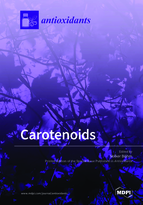Carotenoids
A special issue of Antioxidants (ISSN 2076-3921). This special issue belongs to the section "Natural and Synthetic Antioxidants".
Deadline for manuscript submissions: closed (30 June 2019) | Viewed by 75462
Special Issue Editor
Interests: dietary antioxidants; carotenoids; polyphenols; vitamin E; vitamin C; antioxidant activity/capacity; interactions; bioavailability
Special Issues, Collections and Topics in MDPI journals
Special Issue Information
Dear Colleagues,
The purpose of this Special Issue of Antioxidants is to present recent investigations on the role of carotenoids as antioxidants in health promotion and disease prevention as well as results on the non-antioxidant activities of carotenoids. As the biological activities can only be exerted when the compounds are absorbed, the in vitro bioaccessibility and the in vivo intestinal uptake of carotenoids are important aspects to examine. It is also of interest to describe the recent developments in the structural characterization of the bioactive, endogenous metabolites of carotenoids and in the use of carotenoids in the industry.
Carotenoids are a group of natural pigments, consisting of more than 750 compounds. Their colours are mostly yellow, orange, and red and are due to the system of conjugated double bonds that they contain. This structural element is also responsible for the antioxidant properties of many carotenoids. Carotenoids have shown various biological activities (not only as provitamin A) and are, therefore, an interesting subject for researchers of various disciplines all over the world, investigating, for instance, the disease preventive properties of fruits and vegetables. As lipophilic compounds, their uptake and storage in the body is dependent on various factors. In vitro and in vivo data showed both enhancing and inhibiting effects of matrix constituents on the bioaccessibility and bioavailability of carotenoids.
I invite you to submit original research papers or review articles focusing on all issues related to carotenoids.
Prof. Dr. Volker Böhm
Guest Editor
Manuscript Submission Information
Manuscripts should be submitted online at www.mdpi.com by registering and logging in to this website. Once you are registered, click here to go to the submission form. Manuscripts can be submitted until the deadline. All submissions that pass pre-check are peer-reviewed. Accepted papers will be published continuously in the journal (as soon as accepted) and will be listed together on the special issue website. Research articles, review articles as well as short communications are invited. For planned papers, a title and short abstract (about 100 words) can be sent to the Editorial Office for announcement on this website.
Submitted manuscripts should not have been published previously, nor be under consideration for publication elsewhere (except conference proceedings papers). All manuscripts are thoroughly refereed through a single-blind peer-review process. A guide for authors and other relevant information for submission of manuscripts is available on the Instructions for Authors page. Antioxidants is an international peer-reviewed open access monthly journal published by MDPI.
Please visit the Instructions for Authors page before submitting a manuscript. The Article Processing Charge (APC) for publication in this open access journal is 2900 CHF (Swiss Francs). Submitted papers should be well formatted and use good English. Authors may use MDPI's English editing service prior to publication or during author revisions.
Keywords
- Carotenoids
- Absorption, metabolism, and bioavailability
- Pharmacokinetics
- Antioxidant mechanisms
- Non-antioxidant activities
- Health and disease
- Industrial uses
- Functional properties
- Extraction and chemical characterization of metabolites
Related Special Issues
- The Role of Carotenoids in Human Health (2021) in Antioxidants (10 articles)
- Carotenoids, Oxidative Stress and Disease II in Antioxidants (1 article)
- Carotenoids, Oxidative Stress and Disease in Antioxidants (19 articles)







